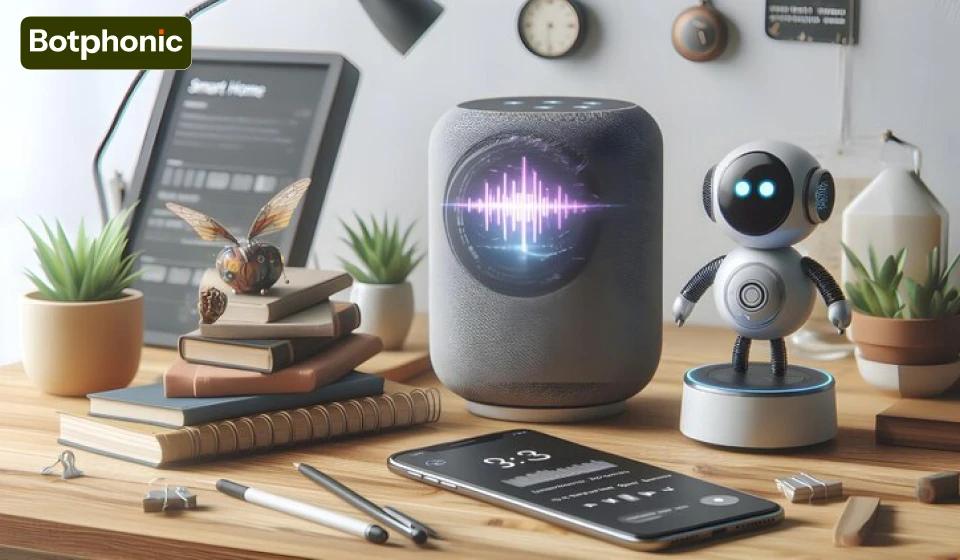
Summarize Content With:
Quick Summary
Call centers have always been crucial for enhanced customer service and regular feedback, but do you know that these days, even call centers have been hiring something other than humans to increase their efficiency. AI voice bots have made their debut in customer service, and it won’t be wrong if we say it’s flabbergastingly grand.
In this blog, we are going to know how AI voicebots are here to increase whole operational efficiency by enhancing customer support and providing better customer service. We will be reading about its benefits, use cases, limitations, and how it can be used in various sectors.
Introduction
AI voice bot is an intelligent tool that is getting used in various sectors to interact with users, or you can say customers, through verbal spoken language rather than writing in a chat. The best AI voice assistant will always have advanced capabilities to continue the interaction and also effectively learns from previous conversations.
What is an AI Voicebot?
An AI voicebot is a smart and voice-enabled software system that interacts with users or customers through spoken language. It is driven by technologies and voicebots that can recognize, interpret, and respond to the same in human speech.
Unlike other traditional systems, which are still following the rigid and pre-programmed paths, these bots are designed to perceive the context, continue the conversations, and even continue learning from previous interactions. This feature makes it more dynamic and capable of managing even complex tasks.
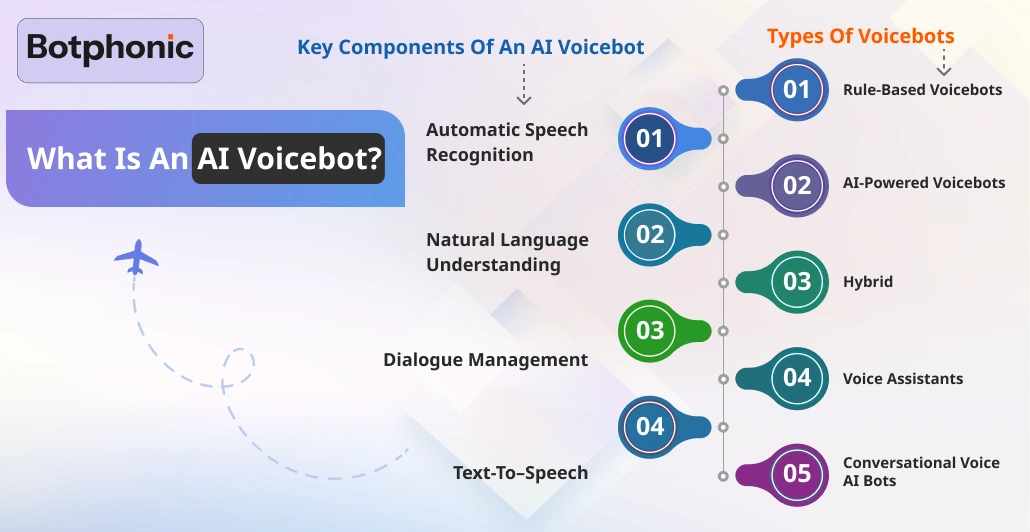
Key Components of an AI voicebot
- Automatic Speech Recognition: Transforms the language spoken by the user into text.
- Natural Language Understanding: Perceives the meaning of input.
- Dialogue Management: Decides about the bot’s behaviour and how it should respond to context.
- Text-to–Speech: It converts the response shared by the bot, which is usually in text, to speech for natural natural-sounding response.
Types of Voicebots
Voicebots are normally categorized based on their technology, level of intelligence, and use cases. Getting to know them helps you choose the right solution for specific needs.
1. Rule-Based Voicebots
Rule-based voicebots are the most basic type of voicebots; they usually follow a pre-defined script and respond to very specific commands or keywords. This works on “if-then” logic and can be used for IVR systems and call routing.
2. AI-Powered Voicebots
These voicebots usually use machine learning, natural language processing, and even contextual understanding to manage the dynamic and major conversations. It uses user inputs to learn and gets better over time.
3. Hybrid
This model is a combined result of rule-based and AI-powered systems, has a medium level of intelligence, and is ideal for a balanced experience. It enables you a flexible option to work with and is cost-effective.
4. Voice Assistants
These are advanced artificial intelligence voice bots that are integrated into devices and apps for effective use, such as Alexa, Siri, and others. It uses cloud-based AI to handle a wide range of requests. It can be used in smart homes, mobile apps, and even personal productivity.
5. Conversational Voice AI Bots
Conversational AI voice bots are a new era and next-gen AI voicebots, which are especially built for natural and multi-turn conversations across several channels. It depends on deep learning and contextual memory for interacting in real-life-like dialogue.
How Does an AI Voicebot Work?
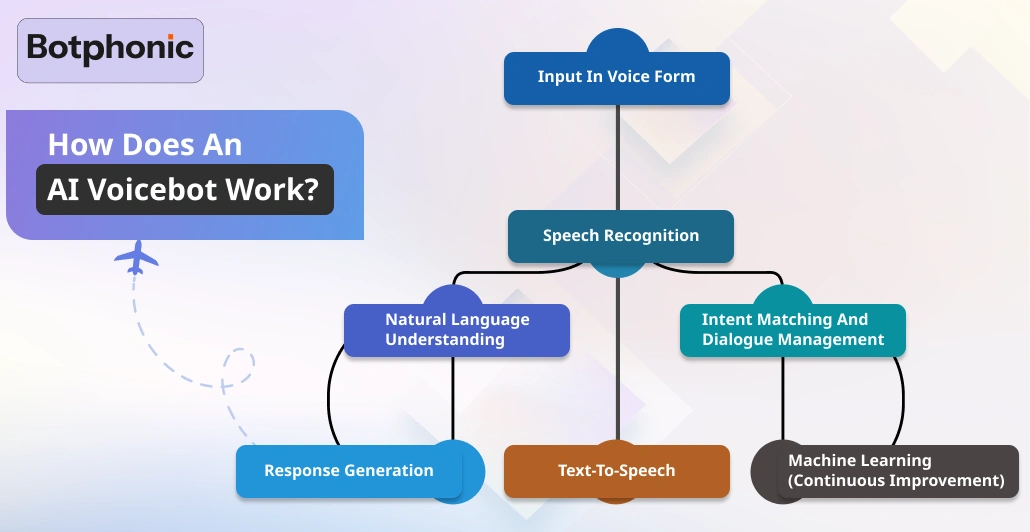
An AI voicebot works by transforming the spoken words into text, realizing the meaning behind it, and generating a suitable response, and all this happens in real time. It involves multiple advanced technologies working together, so it can stimulate a perfect human-like interaction.
This step-by-step process involves:
1. Input in Voice Form
This input is also known as speech capture; the user needs to speak into a microphone, whether it is a phone, a smart speaker, or any particular app. After which, the voicebot captures the input.
2. Speech Recognition
The mentioned voice input is then transfigured into text by using ASR. For example, the spoken phrase “what’s today’s date?” becomes a written text.
3. Natural Language Understanding(NLU)
This helps analyze the user’s intent behind their request, such as identifying that the user is asking for “Today’s date.”
4. Intent Matching and Dialogue Management
The voicebot then decides the next step to be taken based on intent and the conversation’s context. It may pull the information from the database or can ask a few follow-up questions if the intent is not clear.
5. Response Generation
The system then moves forward with a relevant response in text form, for example, “It’s 10th July Today.”
6. Text-to-Speech
The response is transformed into natural-sounding speech after the written response is formed. Voicebot then proceeds to “speak” the answer back to the user.
7. Machine Learning
These voicebots often use machine learning to increase their efficiency with every interaction. They learn new phrases and user preferences to make their predictions better.
These steps will always help you enhance your AI voice bot and use it efficiently.
Why Do You Need an AI Voicebot?
In today’s forward and fast-paced world, customer expectations are growing faster than a child’s teeth. People want quick, accurate, and support whenever they need (according to them, cause they are customers, so why not?). And the most important thing people are no longer introverted about these things; they prefer talking quickly and getting over with it rather than waiting for a chat response.
Here’s why you need an AI voicebot:
1. Instant support
AI voicebots are always there for you, just like your best friend. It offers real-time assistance even outside business hours.
2. Scalability without you adjusting your budget
Unlike humans, these voicebot AI can handle a number of conversations at once without any additional costs or demands.
3. Better Customer Experience
With the ability to acknowledge consumers’ intent and share a tailored response just for them. While holding natural conversations without making them uncomfortable, it makes it easier to scale.
4. Reduced Operational Load
These robot AI voice bots can help you lessen your workload by automating repetitive tasks such as query handling, queries related to appointments, order tracking, and even FAQs.
5. Multilingual and Accessible
AI voicebots can speak and understand multiple languages easily, making it accessible to almost everyone.
6. Data-Driven Insights
Voicebot conversations can easily be monitored and analyzed for trends and to know the customer sentiment on a better scale. It also helps you know customers’ pain points, which in turn helps you improve your service.
7. Be Advanced with this Growing World
In this new era, actions are not louder than words; you have to speak to make your words count.
So get on the trends and get dominant in this digital communication. Adopt an AI voicebot to ensure your growth.
Basically, you need an AI voicebot if you really want to; cut costs without compromising on service quality, enhance customer satisfaction, and operate efficiently.
Benefits of Implementing an AI Voice Bot
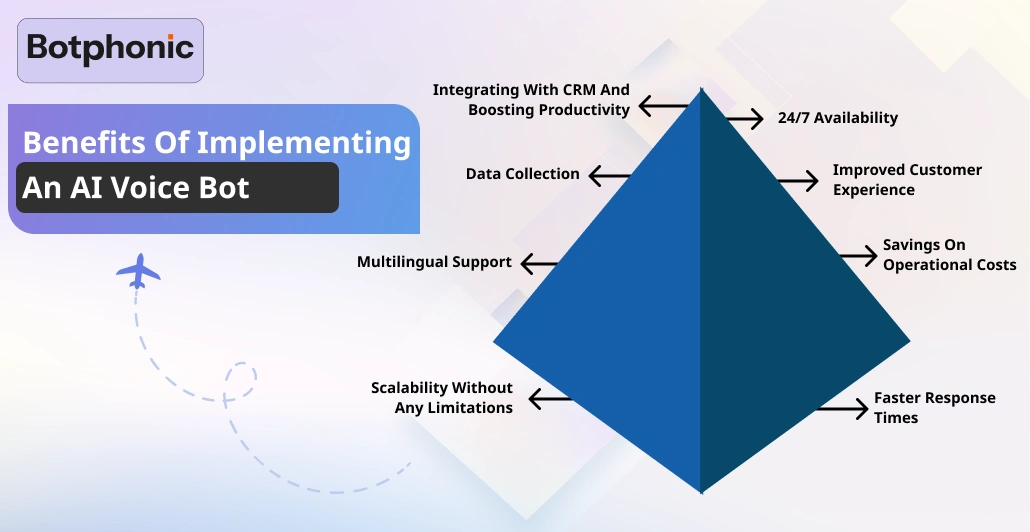
Integrating an AI voice bot into your business can help you grow significantly, because it isn’t just a trend anymore but a strategic move that drives efficiency and increases cost savings.
Here are some key benefits of the same:
1. 24/7 Availability
These AI voicebots effectively work around the whole day and even night, providing you a support just like a therapist. It assists customers with their queries even on holidays and during non-business hours.
2. Improved Customer Experience
With natural-sounding and smart conversations, these help you improve your customer experience. It assists you in delivering fast, accurate, and even personalized experiences.
3. Savings on Operational Costs
These bots help you lessen the need for large teams who have to be always there for customer support; you can always automate the repetitive tasks.
4. Faster Response Times
AI voicebots are always available for you and give answers to your curiosity, or even if you’re confused. It can handle inquiries instantly without any waiting times.
5. Scalability Without any Limitations
Now that it’s the holiday season, you might be facing a sudden surge in calls, but don’t worry, AI voicebots can handle these calls effectively. Whether it’s 1 call or 1000, they can always scale effortlessly without needing any human resources.
6. Multilingual Support
AI voicebots can effortlessly serve your global audience. They can understand and speak multiple languages at once by having interactions with several customers in their preferred language.
7. Data Collection
Voicebots can help you track and analyze the interactions, which help your business gather invaluable insights regarding the same.
8. Integrating with CRM and boosting productivity
Conversational voice AI bots can be easily integrated with your CRM and other tools to allow smart automation, with real-time data access. Automating the tasks and incorporating them boosts the team’s productivity efficiently.
Implementing an AI voicebot helps you empower your company and ensures customer satisfaction, all while reducing costs and keeping you competitive with trends. It’s a smart investment, assuring you long-term value.
Limitations of Voicebot AI
While these voice AIs are offering impressive capabilities, as usual even they have to face some challenges. Understanding their limitations helps you set your expectations on the right page and choose the correct one for your business.
1. Difficulty Understanding Accents
Just as humans, even bots can face the issue of accent as they might not be able to understand the user correctly cause of their accent or due to a noisy background.
2. Limited Emotional Intelligence
Voicebots aren’t yet designed to detect the sentiment of the user while responding to them. It may sometimes lead the user to feel frustrated, and here they may need human reps to understand their situation.
3. Challenges with Complex Queries
They can perform better with predictable conversations that are structured and with context. Voicebots may fail to handle open-ended questions, or even with vague input, they might not be able to respond quickly.
4. Dependence on Data Quality
AI voicebots rely heavily on the data that is provided by the moderator, and due to this, they might not respond to you on a larger scale, as poor-quality data is added.
5. Privacy and Security Concerns
Voice interactions tend to carry sensitive information. If it’s not properly secured, there’s a risk of data breaches, eavesdropping, or even non-compliance with regulations such as GDPR or HIPAA.
6. User Resistance
While AI is usually known by everyone but there might still be users who prefer human interaction over these automated machines.
7. Language and Dialect Limitations
Even though these AI voice bots are made to support multilingualism, they might still not be able to follow regional dialects or slang, which might lead to a lack of proper communication.
AI voicebots are tools that can help you effectively, but you should acknowledge that there’s no one-size-fits-all. Acknowledging their limitations ensures you deploy them effectively and strategically.
Use Case of AI Voicebot Across Industries
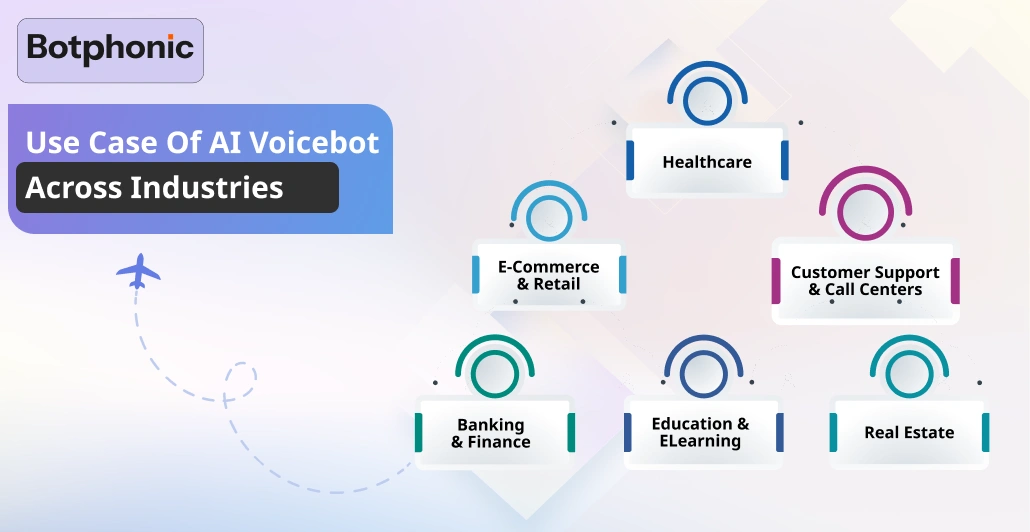
AI voicebots are transforming business communication and strategies; they are helping with task automation, customer experience, and industry insights, too. Let’s see how these voice assistant AI are helping specific industries grow.
1. Healthcare
- Appointment scheduling
- Reminders
- Patient triage and symptom checking
- Bilings
- Insurance reports
By incorporating AI voice bots in the healthcare sector, it helps patients with their tasks, such as appointment reminders, and even with lab report details and other queries.
2. E-commerce and Retail
- Order tracking and status update
- Product recommendations
- Customer support
- Voice-enabled shopping assistants
Retailers can use these advanced AI bots to assist their customers efficiently with live updates regarding their orders and even for product details.
3. Customer Support and Call Centers
- 24/7 automated customer support
- Call deflection and routing
- Voice-based ticket generation
- Feedback collection
Any telecom company can automate a certain percentage of its calls using an AI bot.
4. Banking and Finance
- Balance inquiries and transaction history
- Loan application guidance
- Fraud detection alerts
- Voice authentication
Banks can use voice bot AI to provide their customers with secure account updates and respond to routine queries.
5. Education and eLearning
- Course information
- Enrollment help
- Automated attendance tracking
- Voice-based tutoring and FAQs
- Exam result announcements
Ed-tech can add voice bots to enable students to access digital study material, access the schedule, and even clarify common questions related curriculum.
6. Real Estate
- Property listing
- Scheduling visits
- Voice-guided virtual tours
- Customer follow-ups
- Documentation reminder
- Lead qualification
Real estate can use voicebots to automatically qualify leads and schedule viewings based on interactions.
From customer service to helping with scheduling and other internal operations, voice AI is an innovation that is not just an option anymore but an essential for modern business.
AI Voice Bots vs. AI Chatbots
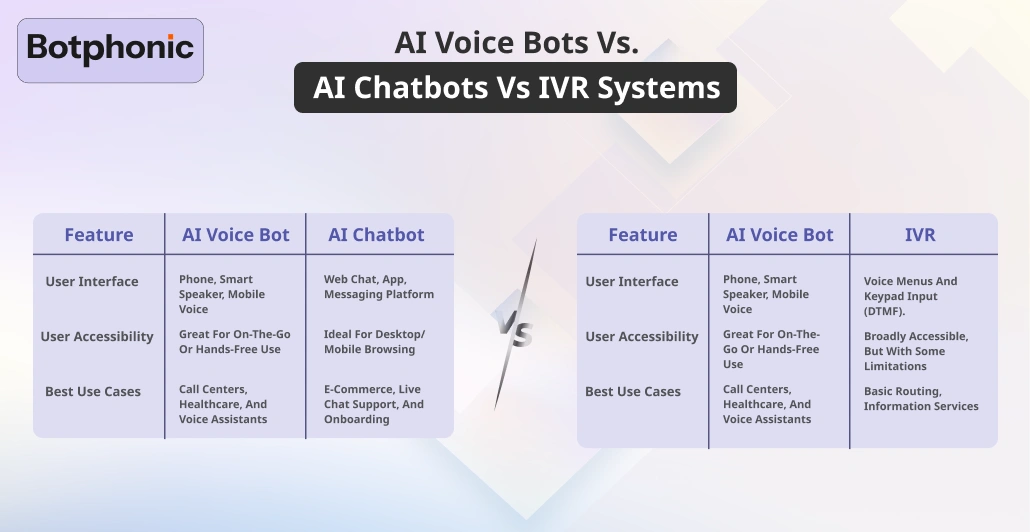
An AI voice bot utilizes spoken language to communicate with users, using calls ot other mediums, whereas an AI chatbot interacts through text-based conversations. It leverages ASR, NLP, and TTS effectively to comprehend voice input and generate favourable responses while the chatbot uses websites, messaging apps. Voice bot uses various channels such as phone, smart speaker, or even voice assistant, for example, Alexa, Google Assistant, Botphonic, and more. Chatbots use NLP and learning algorithms to interpret the data and respond to the input.
| Feature | AI Voice Bot | AI Chatbot |
| Mode of Communication | Voice conversations | Text-based conversations |
| User Interface | Phone, smart speaker, mobile voice | Web chat, app, messaging platform |
| Technology Used | ASR, NLP, TTS, NLU | NLP, NLU, Text I/O |
| Best Use Cases | Call centers, healthcare, and voice assistants | E-commerce, live chat support, and onboarding |
| Response Speed | Real-time verbal responses | Near-instant text responses |
| User Accessibility | Great for on-the-go or hands-free use | Ideal for desktop/mobile browsing |
| Emotional Tone Detection | More contextual with tone and pacing | Limited to sentiment in text |
| Setup Complexity | More complex due to voice tech | Easier and faster to implement |
AI voice bots Vs IVR Systems
AI voice bots have the capability to speak normally and are also able to understand the intent and maintain the context. Whereas, IVR systems use pre-recorded menus and DTMF tones, and sometimes even simple voice commands also work. AI voice bots can easily be integrated into the system and have the ability to scale automatically. While IVR systems are cost-effective and just reliable, they might have a frustrating UX and limited context awareness.
When to Use What?
| Situation | Best Option |
| High call volumes with diverse queries | AI Voice Bot |
| Simple routing (e.g., departments or hours) | IVR |
| Need to scale customer support | AI Voice Bot |
| Tight budget, small business | IVR |
| You want to impress customers with modern CX | AI Voice Bot |
How to Choose the Right AI Voicebot
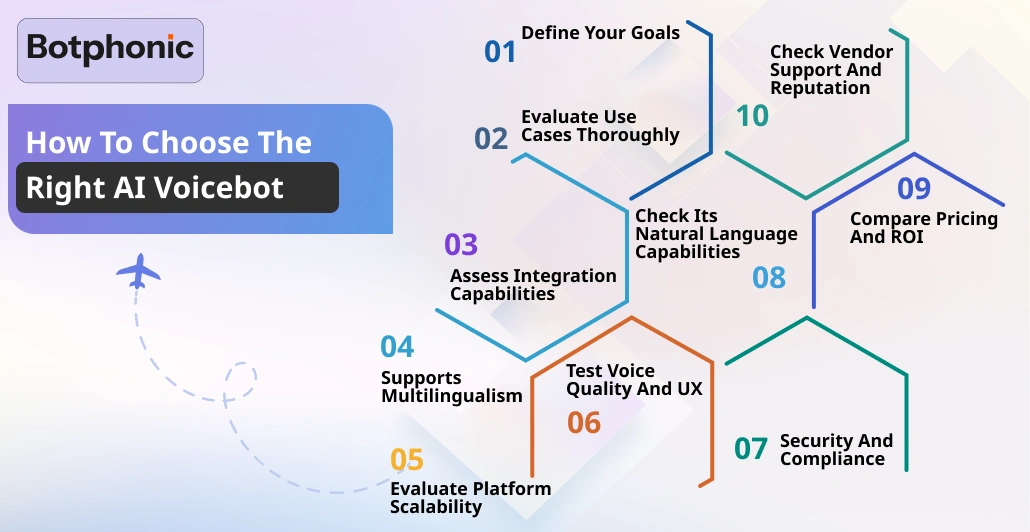
Choosing the right AI voicebot depends on your business needs and customer experience goals. The ideal AI should not just meet your technical requirements but also align with your needs. Here’s a step-by-step guide for you to make a better and right decision.
1. Define Your Goals
Always start by identifying your needs and defining your goal that you want to achieve through a voice assistant.
2. Evaluate Use Cases Thoroughly
Ensure that the platform you have shortlisted supports your use case accordingly, whether it is customer support, order tracking, or anything else.
3. Check its Natural Language Capabilities
Search for an advanced version of natural language understanding (NLU) to handle real and interactive conversations. An eligible AI should be able to understand intent and context, handle accents and variations accordingly.
4. Assess Integration Capabilities
Ensure that your voicebot can easily link with your existing tools, such as CRM, ticketing systems, calendars, and even with databases.
5. Supports Multilingualism
If your business is serving on a global level, choose an AI call assistant that aligns with it and supports multiple languages and dialects.
6. Evaluate Platform Scalability
Even though you are choosing the tools as per your needs but needs and expectations can grow anytime, just like the volume of calls or even tasks. Make sure to choose a platform that scales with high volumes, supports multiple departments, and also evolves with AI training and input.
7. Test Voice Quality and UX
As you have already made your decision to choose a voice bot, ensure that the voice quality is top-notch, as it can make and even break the customer experience considerably.
8. Security and Compliance
Verify that the platform selected supports data encryption, user authentication, and even supports regulatory compliance.
9. Compare Pricing and ROI
Ensure to compare the pricing models of all the models that you have selected and also what pricing model they are using, such as if they are using pay-as-you-go or subscription method, what are the setup costs, and what is the long-term ROI.
10. Check Vendor Support and Reputation
Search for a provider who offers you reliable customer support, transparent documentation, and has a proven track record with case studies and testimonials.
Even though these are a few of the major steps, always make sure to take a free trial or demo of the service platform that is being provided as per your needs. Test its real-world functionality before scaling your deployment.
Why Choose Botphonic?
Botphonic is a well-known voicebot platform that is designed to help businesses deliver their natural, intelligent, and automated voice conversations. It doesn’t matter whether you are a small-scale business or an enterprise, botphonic will be the best AI voice assistant and will always be there with speedy and smart capabilities. Here’s why Botphonic is the right choice for your organization:
1. No-code Voicebot Builder
You can easily create and deploy advanced AI voicebots, even with little to no knowledge of coding.
2. Natural and Human-Like Voices
It is powered by advanced text-to-speech technology for delivering realistic and clear voice responses.
3. Easy Integration
With an easy integration feature, you can connect your CRM and other existing tools with the bot effortlessly.
4. Real-Time Voice Analytics
Track conversation quality, conversion rate, customer satisfaction rate, and user behavior all in real-time and get actionable insights to enhance your performance.
5. Scalable and Reliable
Botphonic is built to handle high call volumes, all while maintaining standardized responses and managing complex interactions.
6. Multi-Industry Use Cases
These AI supports all the industry, it doesn’t matter whether you are in healthcare, e-commerce, finance, or even logistics. Botphonic will adapt to your requirements as you need it to do.
7. Constant Support
Offering round-the-clock support, it never misses a lead, query, or even helps with support to call back the user.
8. Fast Set-Up
Get your voicebot ready in minutes, not weeks. With instant setup and ready-to-use templates, you can effectively deploy your AI voice bots and start growing.
Botphonic is a flexible, easy-to-use, and intelligent voicebot that works as per your requirement and gets you the lead and response that you want.
Conclusion
AI voicebots aren’t just here as a tool, but they are here to transform the world of communication. It offers speed, efficiency, and availability like no one ever has. From handling routine queries to answering in customer support AI voice bot is here to help you. They help companies scale better and be smarter than their competitors. With Botphonic, you can be assured to be at first of following trends and won’t ever have to compromise with your scalability.

